
views
Checking Responsiveness
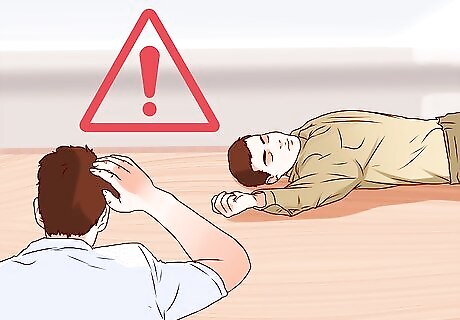
Assess the situation. When you find someone collapsed or you witness someone pass out, look around and figure out if you can reach him without putting your own safety at risk. You also need to see if he is in an area big enough for you to move around and help. If the person looks like he is in immediate danger (such as the middle of a street), try to move him to a safe location before you attempt to help him — but do not put yourself in harm's way. If you rush into a dangerous situation, you may also end up injured. Not only does this not help the person you were trying to save, it also gives emergency personnel yet another person to rescue. Use caution if there is presumed potential neck or spinal injury, such as a person who has fallen from a height or at the scene of an automobile accident where there are signs of additional obvious major trauma. Anyone who has fallen from a height or been involved in an motor vehicle accident should have spinal precautions taken.

Talk to the victim. One of the best ways to check to see if a person is responsive is to talk to him. Ask questions like, "What is your name?", "Are you alright?", and "Can you hear me?" These questions may rouse the victim from whatever haze she is in and make her respond. Also tap her shoulder or arm while you do it to see if that will help as well. If this doesn't work, try yelling once or twice at her to see if that will rouse her. Yell phrases such as "Hey!" or "Hello!" to see if she wakes up.

Perform a sternal rub. A sternal rub may help you to establish that the person is indeed unresponsive. You don't want to do CPR on someone who is just poorly responsive but still breathing and circulating blood. Make a fist and rub your knuckles hard on the person’s breastbone. You can also try a "trap squeeze," which is when you grasp the muscles of the shoulder by your thumb and fingers and squeeze into the hollow of the collarbone. Bend low as you do this and listen for sounds or signs of breathing. Anyone who is simply sedated but breathing should rouse from the pain. Note the reaction, if any, to tell to EMS when they arrive.
Checking the Airways
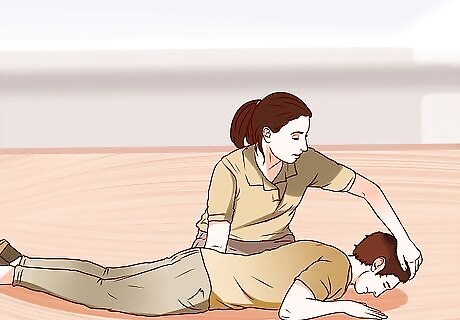
Position the victim. Before you can check the airway, the victim needs to be in the right position. If there is any exudate (vomit, blood, etc.) in or around the person's mouth, put on a glove and remove it to clear the airway before you roll her. Roll the person onto her back. This should be on a surface as flat as possible so her body can be straight and easy to work with. Make sure his hands are down by his sides and his back and legs are straight. Take a moment to push her shoulders down gently. This expands the width of the trachea and helps to keep the jaw lifted.
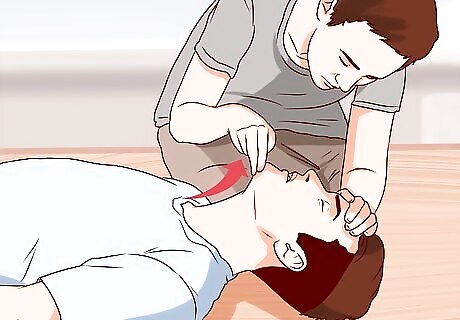
Move the head. To open the airway when he is laying on the ground, his head and breathing passages need to be aligned correctly. Place one hand behind his head and one hand under his chin. Tilt his head backward toward the sky. The chin should end in a slightly lifted position, as if he were sniffing the air.
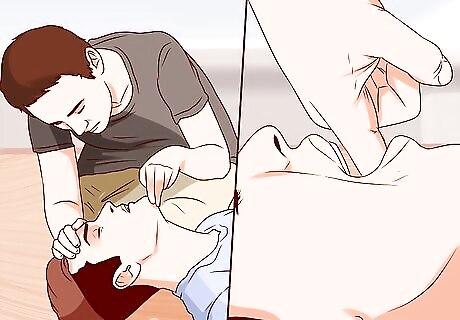
Remove foreign objects from the airway. There may be situations where the airway is obstructed. This may be from a foreign object, by the victim's tongue, or by vomit or other bodily fluids. If the airway is obviously obstructed by vomit or any removable matter, get it out of the mouth with a quick swipes with two or three fingers in her mouth. You can quickly turn the victim’s head to one side to assist in the removal. Try to avoid pushing any matter further down the trachea by only sweeping as far as you can easily see inside the open mouth. Use sweeping motions rather than digging ones. If the tongue is obstructing the airway, try the jaw thrust method. Crouch above her head, looking down toward the toes. Grasp the jaw gently but firmly with both hands, so that you can curve your fingers into the soft flesh of the chin. Gently lift the jaw to the sky without moving the rest of the head. This helps the tongue to fall to the floor of the jaw, rather than settling in the airway.
Checking for Breathing

Look for obvious signs of breathing. There are a few obvious signs that the victim is breathing. Look for the rise and fall of the chest as he takes oxygen into his lungs. Also look for nose fluctuations as he breathes in through his nose and any opening and closing of his mouth as he breathes in and out. If there is not a rise of the chest, try to re-position the airway a little in either direction. You may have gone too far or not far enough to open the airway. If the patient is gasping for breath or breathing poorly, treat this as not breathing and check for circulation.
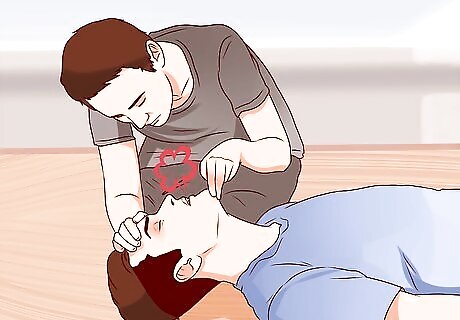
Do a breath check. You can check for breath through feel and sound if you can't see any obvious signs of breathing. Place your hand near her nose and mouth to see if you feel any breath. If you don't, lean your head down close to the patient’s mouth and feel for breath on your cheek and listen for any inhales or exhales. If you hear normal breathing, there is no need for CPR. You should still call 911 if she does not wake up.
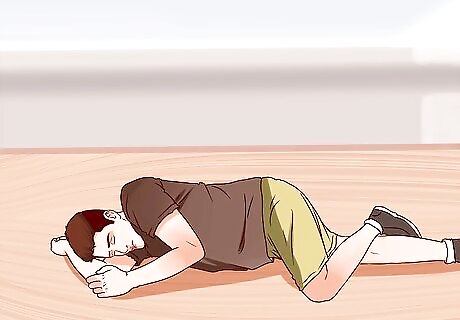
Turn the victim over if breathing starts. Opening the airway may be enough to start the victim breathing again. If this happens, roll the victim onto his side so there is less pressure on his chest. This will help him breathe better.
Checking Circulation
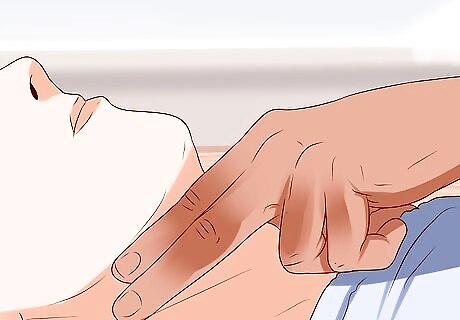
Feel for circulation. Once you find that she is not breathing, you need to check to see if her blood is still circulating. On the lifted area of the chin, place your index and middle fingers to the groove in the neck, just beneath the jaw and to the right or left of the voice box or Adam's apple. Slip your fingers into the groove there. This is the carotid artery and should provide a strong pulse if his blood is circulating well. If the pulse is weak or if there is no pulse, the person is in trouble and you need to seek medical help.
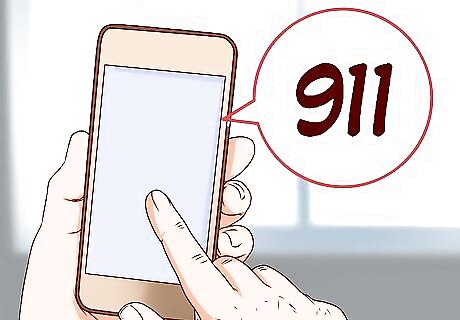
Call 911. If the person is not breathing or has not pulse, you need to call 911. Emergency services can help treat the victim and find the underlying cause for the collapse once they arrive. If you are alone, call 911 first, then attend to the victim. If you are with someone else, have them call 911 while you attend to the victim.
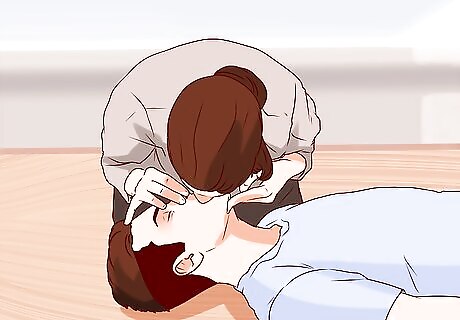
Perform CPR. If the victim is not breathing and his pulse is weak or nonexistent, you need to perform CPR. This will help get his blood pumping, his lungs working, and can help save his life as you wait for medical help. CPR is a life saving technique that can help prolong the life of the victim until professionals can treat the underlying cause of the victim's attack. Make sure you follow the American Heart Associations guidelines for CPR when you administer it to the victim. Consider taking a CPR class to be fully trained on how to properly administer this life-saving procedure. There are different methods of CPR for adults and children.















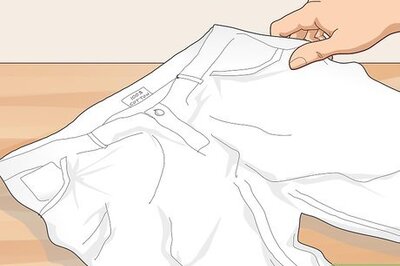




Comments
0 comment